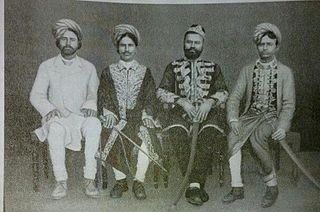
Khatri is a caste originating from the Malwa and Majha areas of Punjab region of South Asia that is predominantly found in India, but also in Pakistan and Afghanistan. The Khatris claim they are warriors who took to trade. In the Indian subcontinent, they were mostly engaged in mercantile professions such as banking and trade. They were the dominant commercial and financial administration class of late-medieval India. Some in Punjab often belonged to hereditary agriculturalist land-holding lineages, while others were engaged in artisanal occupations such as silk production and weaving.
The Other Backward Class (OBC) is a collective term used by the Government of India to classify communities that are "educationally or socially backward". It is one of several official classifications of the population of India, along with general castes, Scheduled Castes and Scheduled Tribes. The OBCs were found to comprise 52% of the country's population by the Mandal Commission report of 1980 and were determined to be 41% in 2006 when the National Sample Survey Organisation took place. There is substantial debate over the exact number of OBCs in India; it is generally estimated to be sizable, but many believe that it is higher than the figures quoted by either the Mandal Commission or the National Sample Survey.

The Tarkhan is a caste found in the Punjab region of India and Pakistan. They are traditionally carpenters by occupation.

Ahir or Aheer is a community of traditionally non-elite pastoralists in India, most of whom now use the Yadav surname, as they consider the two terms synonymous. The Ahirs are variously described as a caste, a clan, a race, and/or a tribe.

Lohar is considered to be a caste among Hindus and a clan among Muslims and Sikhs in the Indian states of Uttar Pradesh and Jharkhand, and in Nepal. They form traditionally artisanal castes. Writers of the Raj period often used the term Lohar as a synonym for blacksmith, although there are other traditional smiting communities, such as the Ramgarhia and Sikligar, and numerous non-traditional communities, including the Kayastha, Rajput and Brahmin.

Teli is a caste traditionally occupied in the oil pressing and trade in India, Nepal, and Pakistan. Members may be either Hindu or Muslim; Muslim Teli are called Roshandaar or Teli Malik. India's Prime minister Narendra Modi is from Teli caste.

Karadiya Rajput is an Indian Hindu caste of the Rajput community.
Khati is a Hindu sub-caste of Vishwakarma community which mainly resides in the northern Indian states of Rajasthan, Haryana, Punjab and the National Capital Region-Delhi. Apart from Khati, they are also addressed as Jangid, Jangra-Brahmin and are classified as an Other Backward Class caste in the central list of National Commission for Backward Classes (NCBC).
The Gurjar are an agricultural ethnic community, residing mainly in India, Pakistan, and Afghanistan, divided internally into various clan groups. They were traditionally involved in agriculture, pastoral and nomadic activities and formed a large heterogeneous group. The historical role of Gurjars has been quite diverse in society: at one end they have been founders of several kingdoms and dynasties and, at the other end, some are still nomads with no land of their own.
Rawal or Raol is a regional variation of the Hindi princely ruler title Raja/Radjah used in some princely states in Rajputana and Western India, and is now also used as a caste designation or surname by several communities in Southern Asia.
Kutch Gurjar Kshatriya are a minority Hindu community of Gujarat in India, who claim to be Kshatriya. They are an artisan community related with masonry, artistic carvings, sculpting and building and construction works. They are also known as the Mistris of Kutch adopting word Mistri, a term used in British India for master-craftsman, thekedar, foreman or supervisor or for those who were expert in building and construction..
The Mistri are a Hindu caste found in state of Gujarat, India.

Chhipi is a caste of people with ancestral roots tracing back to India. These people are basically Rajputs and used to wear Kshatriya attire. These people were skilled in the art of war, Later people of this caste started doing printing work. They are found in the states of Gujarat, Rajasthan, Madhya Pradesh, Haryana, Delhi, Uttar Pradesh of India.

Kumhar or Kumbhar is a caste or community in India, Nepal, Bangladesh and Pakistan. Kumhars have historically been associated with the art of pottery.
Mistry, or Mistri, is an Indian surname. The name can be found among people from Gujarat, Rajasthan, Uttar Pradesh, Bihar, West Bengal, and Bangladesh. This surname is used by Vishwakarma communities of India. It is an occupational surname.

The Thakor Koli, or Thakarda Koli, is a subcaste of the Koli caste of Gujarat. Koli people form the largest caste-cluster in Gujarat, comprising 24 per cent of the total population of the state. Koli Thakors in Gujarat are classified as Other Backward Class (OBC). During his tenure, the former chief minister, Koli community member Madhav Singh Solanki, included all Koli communities of Gujarat in the OBC. Koli Thakors are mostly cultivators or small land-owners.
The Vishwakarma community are a social group of India, sometimes described as a caste. They claim themselves to be Brahmin or of high-status in the caste hierarchy, although these claims are not generally accepted outside the community. The community comprises five subgroups—carpenters, blacksmiths, bronze smiths, goldsmiths and stonemasons— claim to be descendants of Vishvakarma, the builder and architect of heavenly realm, a Hindu deity.
Jangid or Jangid-Brahmin or Jaangid is a sub caste in Brahmin community in India like Brahmin-Vats, Brahmin-Gaur etc., specializing in architectural work, wood work like ship building, wooden furniture making, representing working class people in ancient India. They belong to the Vishwakarma sect. The terms Jangid and Vishwakarma are being used interchangeably in India for centuries. They have a notable presence in the states of Haryana, Rajasthan and Punjab. Jangid are usually known fordecorative works for religious figurines.









